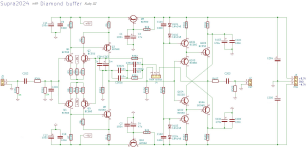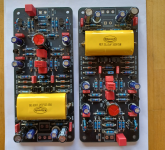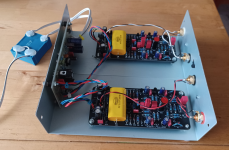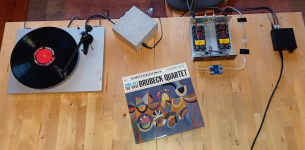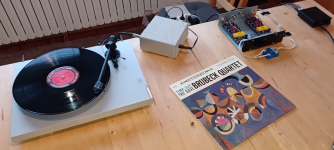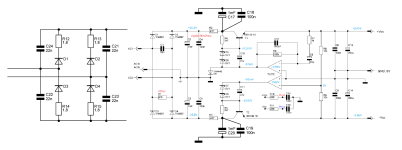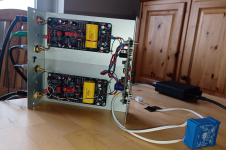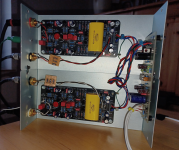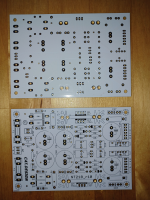Time constants:

Elektor has selected network number 2, also known as the passive AllInOne solution, with R1=150kOhm for its SUPRA; let's just stick with that, also presented in 1980 by W. G. Jung.
R2 = 150kOhm / 12.403 ==> (12kOhm plus 93.85Ohm)
we choose
12kOhm *
C1 = 2937µs / 150kOhm ==> 19.85nF
we choose
10nF FKP || 10nF FKP *
C2 = 81.21µs / 12k094Ohm ==> 6.715nF
we choose
3n3F FKP || 3n3F FKP *
* just like (in) the Elektor-Original
#
What accuracy and precision will we achieve with our three real bodies? Will the ensemble be noisy? Which jumper setting is technically better and which sounds subjectively better?
Questions upon questions.
HBt.
☕
Elektor has selected network number 2, also known as the passive AllInOne solution, with R1=150kOhm for its SUPRA; let's just stick with that, also presented in 1980 by W. G. Jung.
R2 = 150kOhm / 12.403 ==> (12kOhm plus 93.85Ohm)
we choose
12kOhm *
C1 = 2937µs / 150kOhm ==> 19.85nF
we choose
10nF FKP || 10nF FKP *
C2 = 81.21µs / 12k094Ohm ==> 6.715nF
we choose
3n3F FKP || 3n3F FKP *
* just like (in) the Elektor-Original
#
What accuracy and precision will we achieve with our three real bodies? Will the ensemble be noisy? Which jumper setting is technically better and which sounds subjectively better?
Questions upon questions.
HBt.
☕
As we do not want to have a DC offset, R202 and R302 must be the same value, i.e. 150kOhm. A possible DC offset also distorts our beautiful diamond - another reason to use R202 ..!
R202 || r_core_inp || R204 should be 47kOhm
#
a very nice EQ
🙂
(provided there is no noise, especially no sparkle and shot noise)
HBt.
R202 || r_core_inp || R204 should be 47kOhm
#
a very nice EQ
🙂
(provided there is no noise, especially no sparkle and shot noise)
HBt.
Attachments
Since OREAD, my test drive with the cheapest MM I could find and bring over my heart has been dormant, but now ...
Attachments
And quite honestly, I am absolutely speechless.
If this classic equalizer design (which is completely discrete and absolutely symmetrical in design) doesn't outshine my personal two main competitors (you already know who or what I mean), then I've reached the end of my tether.
First of all, I will only carry out extensive dynamic measurements (which will do nothing more than confirm the theoretical principles and the simulations anyway) when my time allows and the aluminum sheets have had to give way to a real housing - or if other replicas have problems and these have to be solved together.
Please bear with me (I'm not in a good mood at the moment, probably due to the black clouds looming in the sky). But, my test SUPRA2014 works perfectly, it is abysmally black and crisp. The jumper is currently on the core output side, i.e. Ruby3 works exclusively as a buffer.
Can I already report something about the comparison with OREAD? Oh, that will be very difficult - they are definitely different and both clearly bear my signature.
OREAD is already awesome, my God, you should have both of them.
😱
HBt.
If this classic equalizer design (which is completely discrete and absolutely symmetrical in design) doesn't outshine my personal two main competitors (you already know who or what I mean), then I've reached the end of my tether.
First of all, I will only carry out extensive dynamic measurements (which will do nothing more than confirm the theoretical principles and the simulations anyway) when my time allows and the aluminum sheets have had to give way to a real housing - or if other replicas have problems and these have to be solved together.
Please bear with me (I'm not in a good mood at the moment, probably due to the black clouds looming in the sky). But, my test SUPRA2014 works perfectly, it is abysmally black and crisp. The jumper is currently on the core output side, i.e. Ruby3 works exclusively as a buffer.
Can I already report something about the comparison with OREAD? Oh, that will be very difficult - they are definitely different and both clearly bear my signature.
OREAD is already awesome, my God, you should have both of them.
😱
HBt.
A quick word about shielding:
I'm currently playing with the electromagnetic coupling on my test surface (a normal beech dining room table).
The analog speedbox has to be far, far away,
the thin aluminum sheets have to be connected to the PE (and GND) ... experiment a little with the setups (i.e. interferences) ... turn the headphone amplifier all the way up ... and listen to the interference(s) ... Noise? Not a chance!
With the most careful setup, there will be practically no noise, no hum. At the moment I'm using the simplest and cheapest (balanced) power supply in the world.
I use the already mentioned power supply (original from Matsushita, brand Technics and Panasonic, Japan) to demonstrate that equalizers do not necessarily need an overkill super-duper PSU.
But this is about shielding: To shield H and B fields, we need three layers of metal: sheet steel, tinplate and copper or aluminum.
I wish us all a lot of fun,
HBt.
Reminder:
Supra2024 plus Ruby III is more sensitive / susceptible to interference than OREAD. But that's no secret, I said it right at the beginning - and it's not a problem if you follow the rules.

I'm currently playing with the electromagnetic coupling on my test surface (a normal beech dining room table).
The analog speedbox has to be far, far away,
the thin aluminum sheets have to be connected to the PE (and GND) ... experiment a little with the setups (i.e. interferences) ... turn the headphone amplifier all the way up ... and listen to the interference(s) ... Noise? Not a chance!
With the most careful setup, there will be practically no noise, no hum. At the moment I'm using the simplest and cheapest (balanced) power supply in the world.
I use the already mentioned power supply (original from Matsushita, brand Technics and Panasonic, Japan) to demonstrate that equalizers do not necessarily need an overkill super-duper PSU.
But this is about shielding: To shield H and B fields, we need three layers of metal: sheet steel, tinplate and copper or aluminum.
I wish us all a lot of fun,
HBt.
Reminder:
Supra2024 plus Ruby III is more sensitive / susceptible to interference than OREAD. But that's no secret, I said it right at the beginning - and it's not a problem if you follow the rules.

the smallest psu

If you also want to test this variant, please increase the charging capacitors C2 & C3, 4700µF is practically optimal, 1000µF is unfortunately the absolute minimum - the circuit is too simple, but still very clever.
If you also want to test this variant, please increase the charging capacitors C2 & C3, 4700µF is practically optimal, 1000µF is unfortunately the absolute minimum - the circuit is too simple, but still very clever.
my testdriver
I'm still amazed at the progress my old Project Audio MDF board has made. Amazing.
By the way, I think I like the oread equalizer a bit better ... purely subjective, because it was less intended for the high-end sector 😉.
Bye,
I now have to listen to a lot of music.
kindly,
HBt.
I'm still amazed at the progress my old Project Audio MDF board has made. Amazing.
By the way, I think I like the oread equalizer a bit better ... purely subjective, because it was less intended for the high-end sector 😉.
Bye,
I now have to listen to a lot of music.
kindly,
HBt.
The most significant difference in sound is quickly identified:
in direct comparison to the OREAD EQ, the supra24 (with ruby3) is warmer and less creaky (I'm referring to the sound of an oboe), it is not as extremely detailed as oread. Technically, its higher internal resistance (in the entire bass and fundamental range) simply comes into play here. With some pop and rock albums from the 1980s, the upper bass and fundamental tone is a little too dense in the atmosphere for me. Well, oread is just damn good, but supra24 isn't bad either, just different. I don't want to pass judgment.
In order to find the cause (perhaps the AT system is maladjusted, but unfortunately I can no longer hear the high and highest tones), I need to take sound spectra - but at the moment I lack the enthusiasm to measure. It will come down to a question of taste. In any case, there are no negative anomalies, which is a very good sign. The thing is very low-noise without the dynamic 16 parallel-connected transistors of the Elektor original. One can be satisfied.
😗
However, our wish for a diamond buffer has a price that we now have to pay, I'm sorry:
with the present design it is not possible to take the buffer into the global negative feedback, i.e. the jumper j4 always remains in its default position.
These are the little technical messes that are only understood retrospectively - "it could have gone well", yes, it could have! No problem, the solution is already working as an approach in my head - the cause is also quite clear. You're always smarter afterwards. No, these points are always part of a development process - we can never do it without a test setup.
I'm sure the JFet buffer will be on my original test setup, but also outside the loop. So either you abandon the idea of having two possible feedback points (and thus also two different equalizers in one) to choose from, or there will be a second version with this option (i.e. a solution). To solve the puzzle, you need two more components.
#
Devilish, I'm just posing the riddle, I want to be mean for once.
😉
@alugner
there is no switch-option, only default ..!
sorry,
HBt.
in direct comparison to the OREAD EQ, the supra24 (with ruby3) is warmer and less creaky (I'm referring to the sound of an oboe), it is not as extremely detailed as oread. Technically, its higher internal resistance (in the entire bass and fundamental range) simply comes into play here. With some pop and rock albums from the 1980s, the upper bass and fundamental tone is a little too dense in the atmosphere for me. Well, oread is just damn good, but supra24 isn't bad either, just different. I don't want to pass judgment.
In order to find the cause (perhaps the AT system is maladjusted, but unfortunately I can no longer hear the high and highest tones), I need to take sound spectra - but at the moment I lack the enthusiasm to measure. It will come down to a question of taste. In any case, there are no negative anomalies, which is a very good sign. The thing is very low-noise without the dynamic 16 parallel-connected transistors of the Elektor original. One can be satisfied.
😗
However, our wish for a diamond buffer has a price that we now have to pay, I'm sorry:
with the present design it is not possible to take the buffer into the global negative feedback, i.e. the jumper j4 always remains in its default position.
These are the little technical messes that are only understood retrospectively - "it could have gone well", yes, it could have! No problem, the solution is already working as an approach in my head - the cause is also quite clear. You're always smarter afterwards. No, these points are always part of a development process - we can never do it without a test setup.
I'm sure the JFet buffer will be on my original test setup, but also outside the loop. So either you abandon the idea of having two possible feedback points (and thus also two different equalizers in one) to choose from, or there will be a second version with this option (i.e. a solution). To solve the puzzle, you need two more components.
#
Devilish, I'm just posing the riddle, I want to be mean for once.
😉
@alugner
there is no switch-option, only default ..!
sorry,
HBt.
We need the Toshiba jFet's and I need the next black disk ... 😎 smoke something and the next cup of coffee ☕
Preliminary remarks:
Who or what guarantees that what I want to hear and hear is not absolutely subjective or the watermark of the equalizing preamplifier? Nobody or the distortion spectrum? Of course the dynamic behavior, the attack, the rise, the impulse -> i.e. two domains. Nevertheless, there may be preferences for a very specific watermark -> I call the watermark the fingerprint of the amplifier, its topology. Unfortunately, this cannot be read from the spectrum alone.
With the personal expectation of absolutely wanting to hear the special creaking of a historical instrument (from memory, because we all hear worse and worse with age, in every respect), I always test listening with one and the same old disk, the oboe concertos by Vivaldi, Marcello and Platti, by the baroque orchestra under the direction of Frans Brüggen.
And here OREAD simply performs better, but that in no way means that there is anything wrong with the new Supra concept. No, supra24 confirms the impression I've had of this topology for over three decades - and I've already heard the original with the very best Ortofon has to offer (and a Platine Verdier turntable).
Loose technical thoughts:
The main idea behind the supra24 was to optimize the quiescent current flow for low noise - and this is below 100µA, among other aspects. Supra2024 deliberately dispenses with the original hairpin resolution approach (although this one condition would even be fulfilled for the single pairs) and backs a different horse - and it worked perfectly. The strange-looking values of the resistors from the E96 series actually indicate this, but nobody asks about it - strange. My German phrase “endlich ausbalanziert” didn't seem to surprise anyone either, but these little things are the real triggers. So what's the point, I'll give it away, the key is the defect current, the current apparently flowing out of the base of the NPN pair and into the base of the PNP pair. Left and right must be minimal in value and, above all, equal in magnitude - at the same time, the collector potentials must be equal in magnitude, absolutely. Neither of these is the case with the original Supra and is quite difficult to achieve anyway - this is where absolute selection and thermal coupling come into play ... who actually has to be in close thermal contact with whom?
...
tbc
(if anyone are interested)
#
Let's move on to the next test LP, because this new EQ is not bad - set it up and test it yourself, there is no noise.
kindly,
HBt.
Psst
{
between the rails each Supra is symmetrical, unfortunately this very typical topology is also overdetermined, quasi twice symmetrical - I think this trick (which of course gives us absolute level symmetry, an undistorted, undeformed swing) could be the cause of my very personal skepticism about this beautiful design for at least three decades.
}
Or I'm just having a bad day today, my wife says it's all down to the menopause ... regardless of biological sex. I have a different theory.
Who or what guarantees that what I want to hear and hear is not absolutely subjective or the watermark of the equalizing preamplifier? Nobody or the distortion spectrum? Of course the dynamic behavior, the attack, the rise, the impulse -> i.e. two domains. Nevertheless, there may be preferences for a very specific watermark -> I call the watermark the fingerprint of the amplifier, its topology. Unfortunately, this cannot be read from the spectrum alone.
With the personal expectation of absolutely wanting to hear the special creaking of a historical instrument (from memory, because we all hear worse and worse with age, in every respect), I always test listening with one and the same old disk, the oboe concertos by Vivaldi, Marcello and Platti, by the baroque orchestra under the direction of Frans Brüggen.
And here OREAD simply performs better, but that in no way means that there is anything wrong with the new Supra concept. No, supra24 confirms the impression I've had of this topology for over three decades - and I've already heard the original with the very best Ortofon has to offer (and a Platine Verdier turntable).
Loose technical thoughts:
The main idea behind the supra24 was to optimize the quiescent current flow for low noise - and this is below 100µA, among other aspects. Supra2024 deliberately dispenses with the original hairpin resolution approach (although this one condition would even be fulfilled for the single pairs) and backs a different horse - and it worked perfectly. The strange-looking values of the resistors from the E96 series actually indicate this, but nobody asks about it - strange. My German phrase “endlich ausbalanziert” didn't seem to surprise anyone either, but these little things are the real triggers. So what's the point, I'll give it away, the key is the defect current, the current apparently flowing out of the base of the NPN pair and into the base of the PNP pair. Left and right must be minimal in value and, above all, equal in magnitude - at the same time, the collector potentials must be equal in magnitude, absolutely. Neither of these is the case with the original Supra and is quite difficult to achieve anyway - this is where absolute selection and thermal coupling come into play ... who actually has to be in close thermal contact with whom?
...
tbc
(if anyone are interested)
#
Let's move on to the next test LP, because this new EQ is not bad - set it up and test it yourself, there is no noise.
kindly,
HBt.
Psst
{
between the rails each Supra is symmetrical, unfortunately this very typical topology is also overdetermined, quasi twice symmetrical - I think this trick (which of course gives us absolute level symmetry, an undistorted, undeformed swing) could be the cause of my very personal skepticism about this beautiful design for at least three decades.
}
Or I'm just having a bad day today, my wife says it's all down to the menopause ... regardless of biological sex. I have a different theory.
What improves my mood enormously? Of course, Madness - the double album DIVINE MADNESS with all the hits of my younger years.
I think SUPRA2024 with Ruby III just needed a little recording time. So our candidate doesn't lack pressure or powerful bass, it rocks.
I can only say that it's best to rebuild the tandem - OREAD for the fine spirit and SUPRA for the party.
HBt.
Which record or genre is next in line?
🎉🥳👯♂️
I think SUPRA2024 with Ruby III just needed a little recording time. So our candidate doesn't lack pressure or powerful bass, it rocks.
I can only say that it's best to rebuild the tandem - OREAD for the fine spirit and SUPRA for the party.
HBt.
Which record or genre is next in line?
🎉🥳👯♂️
Well, if there's one thing supra24 and ruby3 can do really well, it's low and ultra-low bass - this EQ really beats up every woofer.
Several hours with a SuperDuper
It effortlessly reveals all boundaries. Unfortunately, you can no longer change whether you would rather not know them.
My equalizer has undergone another change, which I recommend as a general recommendation:
R107 = 75Ohm
C203 = 20µF MKP
R203 = 2700Ohm (|| 1Meg)
10nF in parallel (I have 11n)
This load is absolutely no problem for our diamond, at the same time we correct the legendary +1 error and create a kind of rudimentary subsonic filter. We halve C303 and set the DC blocker to 470µF. All in all, our total lower cut-off frequency is now around 3Hz. fh at around 200kHz.
Cx
So I haven't decided on C201 yet, it is still unequipped. Whether with or without, there was no change with the individual tones of the test LP ... My line capacity is already fully sufficient. In the end, I will solder in the same value that I use for the OREAD.
Before I get out the big cutlery, I prefer to listen to a few more LPs - because the Supra24 and Ruby3 pair work perfectly.
Enjoy it,
HBt.
🧙♂️
Several hours with a SuperDuper
- DSO (Rohde & Schwarz)
- frequency counter
- headphone and amplifier
- and Tacet's test LP
It effortlessly reveals all boundaries. Unfortunately, you can no longer change whether you would rather not know them.
My equalizer has undergone another change, which I recommend as a general recommendation:
R107 = 75Ohm
C203 = 20µF MKP
R203 = 2700Ohm (|| 1Meg)
10nF in parallel (I have 11n)
This load is absolutely no problem for our diamond, at the same time we correct the legendary +1 error and create a kind of rudimentary subsonic filter. We halve C303 and set the DC blocker to 470µF. All in all, our total lower cut-off frequency is now around 3Hz. fh at around 200kHz.
Cx
So I haven't decided on C201 yet, it is still unequipped. Whether with or without, there was no change with the individual tones of the test LP ... My line capacity is already fully sufficient. In the end, I will solder in the same value that I use for the OREAD.
Before I get out the big cutlery, I prefer to listen to a few more LPs - because the Supra24 and Ruby3 pair work perfectly.
Enjoy it,
HBt.
🧙♂️
A few more quick facts
Input impedance(10kHz) = 44.55kOhm || 40.6pF
6.4pF of which falls on the chinch panel jack
For a MM system that wants to be loaded with 47kOhm, this means that we have to increase R204 (from 68kOhm) to 75kOhm or replace it. Conversely, we can now simply calculate r_inp ---> 931kOhm --> Core-Impedance || 34.2pF.
SNR (unweighted) > 75.5dB with connected MM system, connection cable, no shielding-case, with standard level (test record); i.e. A-weighted we are /will really good.
Overload reserve > 12dB in relation to the standard level another 5dB are added, i.e. clipping is completely unlikely (even though the core is only supplied with +/- 9Vdc).
Quick and unembellished in the evening -
tomorrow perhaps the real deviation from the RIAA characteristic curve.
tbc
Input impedance(10kHz) = 44.55kOhm || 40.6pF
6.4pF of which falls on the chinch panel jack
For a MM system that wants to be loaded with 47kOhm, this means that we have to increase R204 (from 68kOhm) to 75kOhm or replace it. Conversely, we can now simply calculate r_inp ---> 931kOhm --> Core-Impedance || 34.2pF.
SNR (unweighted) > 75.5dB with connected MM system, connection cable, no shielding-case, with standard level (test record); i.e. A-weighted we are /will really good.
Overload reserve > 12dB in relation to the standard level another 5dB are added, i.e. clipping is completely unlikely (even though the core is only supplied with +/- 9Vdc).
Quick and unembellished in the evening -
tomorrow perhaps the real deviation from the RIAA characteristic curve.
tbc
About the complex input impedance
Of course, I automatically loaded and loaded the sensitive MM input of our switched-on preamplifier directly with a digital super duper (made the same mistake again? ), a test that anyone would perform unthinkingly these days. Why? Because it's convenient, simple and quick. |Zin| -> 44.55kOhm || 40.6pF is the readable value of an LCR bridge. Today we still call it a bridge synonymously, although the determination method has nothing, absolutely nothing to do with that of the classic analog measuring bridge - so be it.
However, we are not at all interested in this automatically generated Rp plus Cp value, because we do not know how our high-impedance input of the core reacts to the unknown level of the test signal, nor do we know the further determination procedure of the digital super duper (for now).
We have to go the hard, analog way to determine the impedance, there is no other way. We are faced with a classic case, an analog amplifier specialized for very, very tiny analog signals (sine and cosine oscillations /voltages). In the OREAD thread you can read how you can achieve this easily and with home remedies. However, care is the top priority here.
We must never forget that the input of our equalizer must be specially designed for the needs, let's say, of the mechanical pickup. Transformed to the electrical side, of course. We need an understanding of the pickup, as a generator, as electrical energy or voltage source - but a voltage source has an internal or output resistance tending towards zero ohms ... we all know that a MM will have a very specific and dependent internal resistance. Dependent, dependent on what?
For this reason alone (even if we should not know what an MM is electrically), our intention must prompt us to skeptically question automatically generated measured values.
#
The measurement, or rather the determination, of the complex input resistance of our supra24 must be repeated.
See for example
The same applies to the recording of the transfer function, i.e. our equalization curve. If you want to proceed adequately and correctly, do it exactly as our forefathers did. Later comparisons with automated procedures are extremely interesting (but also just as superfluous).
HBt.
Of course, I automatically loaded and loaded the sensitive MM input of our switched-on preamplifier directly with a digital super duper (made the same mistake again? ), a test that anyone would perform unthinkingly these days. Why? Because it's convenient, simple and quick. |Zin| -> 44.55kOhm || 40.6pF is the readable value of an LCR bridge. Today we still call it a bridge synonymously, although the determination method has nothing, absolutely nothing to do with that of the classic analog measuring bridge - so be it.
However, we are not at all interested in this automatically generated Rp plus Cp value, because we do not know how our high-impedance input of the core reacts to the unknown level of the test signal, nor do we know the further determination procedure of the digital super duper (for now).
We have to go the hard, analog way to determine the impedance, there is no other way. We are faced with a classic case, an analog amplifier specialized for very, very tiny analog signals (sine and cosine oscillations /voltages). In the OREAD thread you can read how you can achieve this easily and with home remedies. However, care is the top priority here.
We must never forget that the input of our equalizer must be specially designed for the needs, let's say, of the mechanical pickup. Transformed to the electrical side, of course. We need an understanding of the pickup, as a generator, as electrical energy or voltage source - but a voltage source has an internal or output resistance tending towards zero ohms ... we all know that a MM will have a very specific and dependent internal resistance. Dependent, dependent on what?
For this reason alone (even if we should not know what an MM is electrically), our intention must prompt us to skeptically question automatically generated measured values.
#
The measurement, or rather the determination, of the complex input resistance of our supra24 must be repeated.
See for example
The same applies to the recording of the transfer function, i.e. our equalization curve. If you want to proceed adequately and correctly, do it exactly as our forefathers did. Later comparisons with automated procedures are extremely interesting (but also just as superfluous).
HBt.
Last edited:
But
Nowadays, we can really trust our simulation results - and can apply virtual measurements or other ways of determining a parameter to our models.
Who will set up a model of the current SUPRA2024 and determine R and C of the input, i.e. the load that our MM will see under real conditions?
HBt.
🙂
Nowadays, we can really trust our simulation results - and can apply virtual measurements or other ways of determining a parameter to our models.
Who will set up a model of the current SUPRA2024 and determine R and C of the input, i.e. the load that our MM will see under real conditions?
HBt.
🙂
On the (possible) power supply design
If you look deep into the noise that can be measured at the output of the EQ (here Ruby), into the noise, you will find tiny (and really very narrow) switching pulses in the 100Hz rhythm ... How to make something like this visible is a topic outside the scope of this thread, I just want to point out that there is still something hidden.
Let's flux expand the simple and discrete symmetrical voltage regulator - and pray that we will no longer find any artifacts in the noise.
I'm going to take a break for a while and enjoy a few more records with a flawless supra24 plus ruby3. Perhaps we are now experiencing a veritable wave of replicas and interpretations of the two EQ concepts, their respective cores. That would be nice.
From my side:
everything is on GO.
HBt.
If you look deep into the noise that can be measured at the output of the EQ (here Ruby), into the noise, you will find tiny (and really very narrow) switching pulses in the 100Hz rhythm ... How to make something like this visible is a topic outside the scope of this thread, I just want to point out that there is still something hidden.
Let's flux expand the simple and discrete symmetrical voltage regulator - and pray that we will no longer find any artifacts in the noise.
I'm going to take a break for a while and enjoy a few more records with a flawless supra24 plus ruby3. Perhaps we are now experiencing a veritable wave of replicas and interpretations of the two EQ concepts, their respective cores. That would be nice.
From my side:
everything is on GO.
HBt.
Attachments
Hi-five, hbtaudio! 🙂This load is absolutely no problem for our diamond, at the same time we correct the legendary +1 error and create a kind of rudimentary subsonic filter. We halve C303 and set the DC blocker to 470µF. All in all, our total lower cut-off frequency is now around 3Hz. fh at around 200kHz.
Ed
Thank you very much Ed,Hi-five, hbtaudio! 🙂
Ed
your praise makes me very happy. However, the compliment must also go to Morten, because Morten is responsible for the freely available layout, the PCB. Without Morten, there would be no new Supra approach (put into practice) for a long time yet.
Not to forget, Alugner was the first to bravely embark on the adventure.
And the journey continues
Greetings,
HBt.
Attachments
I'm undecided, what am I going to do with these two wonderful circuit boards? They are actually predestined to be used to implement an adjustable laboratory power supply, but they are far too good for a small RIAA EQ.
PCB and here
All that's missing is a housing and the package is complete.
For the sake of completeness, the following should be mentioned here:
SLN-Thread a strange thread that dragged on, stranded in nowhere ten to n years later, sad.
Bye,
HBt.
☕
PCB and here
All that's missing is a housing and the package is complete.
For the sake of completeness, the following should be mentioned here:
SLN-Thread a strange thread that dragged on, stranded in nowhere ten to n years later, sad.
Bye,
HBt.
☕
Attachments
A brief summary of the last checkpoints:
The simulation confirms the value of the resulting input capacitance, so we believe the automatic measurement.
R204 essentially determines the real part of our terminating impedance. 75kOhm now leads to the desired 47kOhm. It is best to make this X and the other X variable, i.e. interchangeable, perhaps using a small base /socket.
220nF < C202 < 2µ2
100pF > C201 > 0
R203 should not be smaller than 2k7, it depends on the size of the input resistance of our further processing amplifier, i.e. the downstream preamplifier represents a load for Ruby3. A value of 10kOhm || 470pF would not be atypical. Now we have to increase R207 to 3k9Ohm. The added C206 is also less than or equal to 10nF in total.
Jumper J4 always short 3 and 2, there is no option any more !
The simulation confirms the value of the resulting input capacitance, so we believe the automatic measurement.
R204 essentially determines the real part of our terminating impedance. 75kOhm now leads to the desired 47kOhm. It is best to make this X and the other X variable, i.e. interchangeable, perhaps using a small base /socket.
220nF < C202 < 2µ2
100pF > C201 > 0
R203 should not be smaller than 2k7, it depends on the size of the input resistance of our further processing amplifier, i.e. the downstream preamplifier represents a load for Ruby3. A value of 10kOhm || 470pF would not be atypical. Now we have to increase R207 to 3k9Ohm. The added C206 is also less than or equal to 10nF in total.
Jumper J4 always short 3 and 2, there is no option any more !
Attachments
Last edited:
- Home
- Source & Line
- Analogue Source
- MM-EQ; the SUPRA2024
